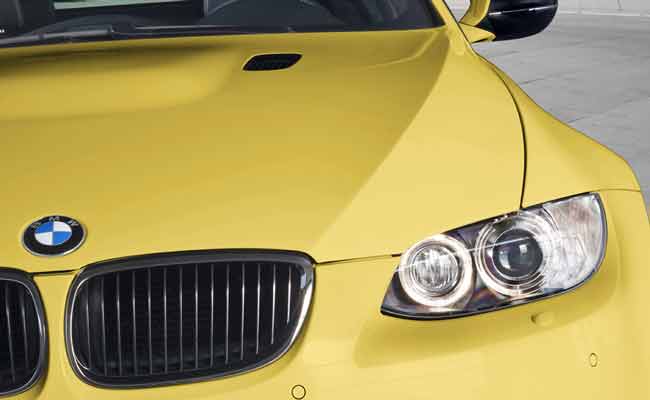
BMW China President and CEO Karsten Engel on how China became the company’s largest market globally, and how things are shaping up in the ‘New Normal’.
Three German automakers—BMW, Audi and Mercedes-Benz—rule China’s luxury car market. BMW entered China in 1994, a time when car imports weren’t really permitted unless you had a special license. In its first year in China, BMW sold 800 cars. Ten years later it sold 20,000. A joint venture agreement signed with Brilliance China in 2003 gave BMW the ability to produce cars locally, which contributed to its spectacular rise in the Chinese auto market—the company sold 450,000 cars last year, a number that is still growing.
The year 2013 marked a significant turning point in BMW’s China journey: China became its biggest market in the world. In this interview, Karsten Engel, President and CEO of BMW Group China, talks about what it takes to succeed here, adjusting to the “new normal” and marketing to the Chinese consumer.
Q. As someone sitting at the helm of the company and watching this market change, what does it take to quickly adapt and grow in China?

A. The key of our strategy is that we are in China with Chinese people, for China. Knowing that [China] will become a very big market, we always had a team here consisting of mainly excellent Chinese people, and expats only in those positions where we needed them, to train our Chinese colleagues. This has proven to be a very successful [strategy] as it helps us integrate the four legal companies we have here in China: our import company, our joint venture, our financial company and our purchasing company. With this strategy we think we are well suited for all the challenges [of] the future.
Q. In some ways you had a bit of a late start in China in 1994, Audi was already here and pretty well entrenched in this market when you entered. How did that impact your entry strategy?
A. We saw that there will be a premium market in China. The car market had started in the mid-1980s, and there were, of course, people still on bicycles. The first cars were very simple. In 1994 we saw the emergence of the premium segment. So it was not a delayed start, it was perfect timing to coincide with the emergence of the premium market. It proved to be very efficient as we were able to build the knowledge and the network before we took the big step of going into the joint venture. We had a good understanding, and this also helped us to find the most suitable partner for production.
Q. In some ways China was also a risky bet back then: what if the premium market did not take off as expected?
A. We saw this development in many countries. First of all, individual mobility seems to be a desire of the people—they want to have a car. Once they have a car they want their next car to be better. So there is a normal way upwards in the direction of the premium. The growth of the overall car market in China is similar to the GDP growth of the country, but the premium car market is always growing stronger, faster than the normal passenger vehicle market. So we saw positive development over the past 20 years—premium developed much stronger, and we also expect the premium segment to develop faster than the passenger car market in the next 5-6 years.
Q. Despite the slowdown and the clampdown on luxury purchases?
A. This is independent. Our customers are people who have a bit more money than others. To enter the premium segment, you should [have] more than $80,000 net household income per year, and there are currently about 15 million households in China in this bracket, and we expect this to triple to 45 million in the next 10 years. These are potential customers. The GDP growth, of course, helps the emergence of the middle class. There is already quite a lot of accumulation of wealth in China. Of course there are topics like anti-corruption, anti-monopoly, which will also stabilize the political and economic base of this country, so it’s all in the right direction.
Q. What are you doing to tap smaller cities and also the western region in China which are obviously very different from Beijing and Shanghai?
A. The growth in China of the overall market will come more from the western regions and from the smaller cities, and we were the first to concentrate on building dealerships there. We still have the largest number of dealers in tier 3, 4 and 5 cities and are concentrating on developing more cities in the future. In a lot of cities we are the first premium car dealer, so this helps the brand, because we can establish the brand before competition, but also there are special challenges. A BMW [dealership] in a smaller city is one thing, but having the right people, being able to do the job in the best possible way and to a high level of customer satisfaction [is another]. So we are running the biggest training program in the world—about 50% of all the training days we are conducting worldwide are being done in China; more than 250,000 man training days. Nobody has done this before. We get younger people [and] train them. Those people are relatively stable so the attrition rate is not too high in the dealership, not as high as elsewhere. And we can build our brand. We need new concepts for our dealerships in those cities¬—they must be smaller, concentrating on service and providing customer satisfaction.
Q. In China you need to market in very innovative ways, and one of the tools you deployed was the BMW Lifestyle shop which carries BMW-branded merchandise, such as super expensive bicycles. Maybe you were targeting consumers at a very perceptual level. Can you explain the thinking behind it?
A. We have more than 20 of these Lifestyle Shops in China, and we decided [on] this concept more than 10 years ago as we did not have many dealers at that time. It’s only in China, but as we now have a lot of dealers who are selling lifestyle, we don’t need these shops any more in tier 1 cities. We still have some at airports, and [in] tier 2 or 3 cities, but all the others are slowly disappearing. The concept is not necessary now for this, but we have concepts here, where the dealerships are more outside Beijing, so we need fast lane service, where customers can drop their cars off in the morning and pick them up in the evening, and we take care of the service somewhere. These are China-specific projects which are developed here. After a couple of years they will probably disappear.
These Lifestyle Shops were there to create brand awareness. They were profitable. We had them in excellent locations where we would not normally have a BMW dealership, and at that time many people did not know what BMW stood for, so they saw our logo and they got in contact with our brand at an early stage, and they probably saw the BMW advertisement later and said, “I probably can’t afford the car now, but at least I’ll take a T-shirt or a hat or a bicycle!” Everything helps to build up brand awareness—you have 1.3 billion people living in China and you couldn’t do enough advertisement in the print media or television at that time to get close to all of them. Today it’s easy, with smartphones [and] new channels to approach new customer groups, to approach younger people and to get in dialogue with them.
Q. What are some of your new marketing concepts?
A. The most important is our experimental marketing. Car drivers are young, they are born post-80, and soon post-90. The concept of premium has not been fully developed as in other mature countries, so the best way to make people feel the innovation and the class of BMW is to let them drive. So we are doing extensive experimental marketing—going to cities, inviting people to [test] drive the car, to do drivers training… Especially now in the smaller cities—we are not doing it in the bigger cities any more, they are mature enough—that’s the approach to enter. The new concepts of cars—like the 2 Series Active Tourer—are for people who do a lot of outdoor activities, or small families who want a premium car. They are also the main target group in smaller cities, and probably this car will be the first premium car those customers will buy. Once you have them, it’s up to the dealer and our normal marketing to keep those customers loyal.
Q. And where does e-commerce fit into all of this?
A. It is getting more important by the day. In the normal communication via print or TV, you create awareness. There’s a new product for your brand, so people aspire to your brand, they probably aspire to your product. But there are so many products. You can’t communicate them all via print or TV. So e-commerce, or ‘e-communication’, is becoming the most important way to communicate. For some of the cars we are only in that area—we are not going in print or TV.
Q. So this depends on the segment?
A. You can target much better your target customers than in the past. E-commerce, then selling via smartphones, this has not really started. The consumer today is very well informed via smartphones—actually 70% of the post-80s [generation] only use smartphones for their communication. They are extremely well-informed. They go to the dealership and say, “I want this car, and by the way, this is the price of the car [that] I can get, can we talk about this?”. A car is still a high-touch, high-feel product—you want to see it, look at the color and the leather, sit in it and do a test drive. And you would anyway need a very close link to the dealer for insurance and maintenance. The actual sale is in the dealership, and afterwards the dealing [with the customer] is between the dealer and the consumer directly in the dealership.
We have several [tie-ups with] all these verticals—Autohome, Tmall is the latest one…. We started with [selling the] Mini [on Tmall] and now with BMW. It works well. It’s more a marketing tool in this way, it’s not really our intention to sell a lot of cars via this [approach].
Q. How do you view the electric vehicle opportunity?
A. It’s a big one all around the world, and China will become the largest market for new energy vehicles worldwide. The government is determined to make it successful, for good reason—there are so many cars on the road, [and they] influence air pollution. The energy for new energy vehicles is being produced somewhere, then it comes to the car via the wall box. We are in very close contact with the Chinese government in helping them build this industry. We are also installing wall boxes for all our customers, so you can’t buy an electric car from us without a wall box. And only if your landlord permits you to install a wall box or a socket or whatever, will we sell you the cars.
The target of the government, 1 million cars in 2020, is achievable. It is not a lot actually in a market that will sell about 25 million cars in 2020, it is still only 4%. We are developing along with our joint venture cars in China, for China. The 530LE is the first premium plug-in hybrid car developed in China, and produced in China, and only sold in China, and there will be more cars coming.
Q. Do you see a lot of competition within this segment? There’s obviously Tesla, which is very expensive, and then there are all these Chinese cars which are at the low-end.
A. The car industry is probably one of the most competitive industries worldwide. This specific industry, new energy, is just emerging, so there is no real competition yet, there are not many products yet available. There are some coming in the lowest segment, but in the [high-end] segment, everybody is trying to develop the cars and figure out in which direction it will go. The numbers we are selling are still very small—the main reason is the lack of recharging infrastructure, but this will come, and the government programs are very extensive here. This market will come, also supported by government regulations. Here in Beijing we have now 150,000 car licenses [a year]. It used to be 10% and now it’s 20% of these cars have to be new energy vehicles. The government is steering it actively in that direction.
Q. What does “the new normal” in China look like from the automobile sector’s point of view?
A. We have to be happy that the growth rates of the past are past and gone—30-40% growth rate a year is not sustainable for the country and the company because you can’t build the knowledge, network, quality [and] customer satisfaction with those rates. So if you have rates of 6%, 7%, 8%, it’s still a huge growth, as the base is now very large in China—it’s the largest car market in the world—so with such growth numbers, on a normal level, it’s much better and more efficient to live with, than with a higher number of the past.
We do expect further growth, but it’s also going in other areas of the business—in the past our dealers sold the car and made profits, and in March we had the 2 millionth car on the road in China. Aspects like after sales [service] are much more important now. Additionally, used car business and financial services are growing. Operational lease is not yet here in China but will come. Once we have all these areas we have a very mature market, with all aspects of the business involved, which we did not have in the past. So then it’s normal for us.
(Photo courtesy: BMW.com)


















